100,000 Holy Sunday Pilgrims in Ludbreg in 2019, 2020 a Little Different (VIDEO)
September 24, 2020 - Holy Sunday in Ludbreg took place early this month, a pilgrimage which usually attracts 100,000 visitors over the first weekend of September. 2020 was a little different.
One of the challenges in Croatia is this most challenging of years has been how to strike a balance between social distancing and the upholding of religious tradtions which date back centuries. I was fortunate to be one of the few witnesses of the 500-year-old Za Krizen (Behing the Cross) procession that took place on the island of Hvar on Maundy Thursday, back in April. Permission for the procession to go ahead, even with each of the 6 processions reduced to 15 people, was a hotly debated national discussion. With lockdown all over the country, this was possibly the only event to take place that month in the whole country.
Religious traditions are a crucial part of the Croatian soul, and there are several annual events which routiinely attract tens of thousands of pilgrims, if not more. All have been much reduced this year due to the virus, and I was curious to see how things looked in practice.
One of the biggest is Holy Sunday in Ludbreg, which takes place on the first weekend of September each year. Pilgrims gather to commemorate which is actually Croatia's only certified miracle, the Eucharistic Miracles of Ludbreg, back in 1411, which was authenticated by Papal Bull in 1513 by Pope Leo X. You can learn more about it here.
While the Varazdin Diocese decided that the event would go ahead, local Ludbreg authoroties decided to downplay the ancillary events, and the usual concerts and exhibitions were put on hold for a brighter 2021.
While not as busy as previous years, several thousand did show up to attend Holy Mass in the park in front of the Sanctuary of the Special Blood of Christ, before enjoying the rest of the festivities around Ludbreg.
Ludbreg has yet to record a single case of coronavirus, and the miracle town remains COVID-19-free after its special weekend - a miracle in itself in these crazy times?
Check out Holy Sunday in Ludbreg 2020 v 2019 in the latest One Minute Ludbreg video below.
To learn more about Ludbreg beyond its stereotype as the centre of the world, read Marc Rowlands' Ludbreg, the Croatian Road Less Travelled.
For the latest travel info, bookmark our main travel info article, which is updated daily.
Read the Croatian Travel Update in your language - now available in 24 languages
Ludbreg Holy Sunday Feast Prepares For 100, 000 Pilgrims
August 28, 2020 - The traditional Ludbreg Days of Holy Sunday usually attracts more than 100 000 pilgrims. The feast will be held from 3 - 7 September under special epidemiolocal measures.
So popular is the traditional visit of the faithful on Ludbreg's Holy Sunday that the event is usually stretched out over ten days. But not this year. The event duration has been reduced due to the ongoing pandemic. Under special epidemiolocal measures, the town is still prepared to welcome as many as want to come. "It's impossible to plan for an exact number of how many will come," Ludbreg Tourist Board director, Andreja Horvat tells TCN. "Some will not come out of fear; some will come because it is a church holiday. There are no organized buses this year, and we have reduced promotion to a bare minimum because we do not want to invite people to a large gathering. But, for however many who do come, we are prepared."
This year there will be no accompanying programs (concerts, exhibitions, promotions, etc.). All masses will be held outdoors, i,e in the sanctuary. Following the masses, pilgrims will be invited, as usual, to attend the outdoor market, which will still take place on the town streets and the central square. To afford everyone more room, this year the amusement park has been moved to Otok Mladosti (The Island of Youth).
The lack of knowing exact numbers has given some difficulties to local caterers. They don’t know exactly how they should prepare for these days; how many will come? Will they stay and eat after Mass, as they usually do? How much food should they order?.
"Given that the situation is changing from day to day, we hope that we already have plans for everything," says Andreja Horvat. "Still, we expect new civil protection measures against Coronavirus for Varaždin County on September 1. Whether they will relate to the reduction of the number of people at various gatherings, we do not yet know."
Ludbreg's Days of Holy Sunday is based on a long tradition of pilgrimage to a unique Croatian sanctuary. Pope Leo X in 1513 acknowledged and confirmed the miraculous appearance of the Blood of Christ that took place in 1411 in the chapel of today's Batthyany Castle, Ludbreg. Ever since, pilgrims from all over the world have been drawn to the town, its shrine, and the Holy relic.
Ludbreg is unique within Croatia and one of the few shrines in the Christian world confirmed by a written decree from the Pope. The miraculous event is said to have taken place when a priest doubted the words of the transubstantiation of the bread and wine into the true body and blood of Jesus. Shortly afterward, the actual Blood of Christ is said to have appeared. Word of the miracle soon spread around the Christian world and pilgrimages began, even before the confirmation by the Vatican.
The faithful have visited since then, especially gathering each year during the ten days of Ludbreg Holy Sunday. Today, the Holy relic can be visited in the parish church of the Holy Trinity, where it is held in a chalice and kept in a beautiful baroque display.
Take a look at TCN's video stories about Ludbreg to learn about the tallest statue of St. Vincent in the world or about Sara Kolak, the town's gold-winning javelin thrower who brought her gold medal back from the 2016 Olympics in Rio.
If you want to learn more about the miracle city, read our detailed travel guide: Discover The Croatian Road Less Travelled: Ludbreg.
For the latest travel info, bookmark our main travel info article, which is updated daily.
Read the Croatian Travel Update in your language - now available in 24 languages
Join the Total Croatia Travel INFO Viber community.
Visit Ludbreg on the Croatian Road Less Travelled
July 9, 2020 - Continuing the TCN series, The Croatian Road Less Travelled, Marc Rowlands explains why you should visit Ludbreg.
Situated in the far north of Croatia, just south-east of Varaždin and Čakovec and less than 20 kilometres from the border with Hungary, the small and picturesque town of Ludbreg is one of incredible contrasts and one with no small amount of ambition. Its close proximity to such neighbours pales into insignificance when you see the places Ludbreg would rather be judged against - this town is known as the Centre Of The World. The moniker was attributed when it was discovered, by accident, that it lies equidistant between many significant cities. Capitalising on the name, Ludbreg has charted these cities and their distance in a circular stone paving feature which can be found in the town's central square. 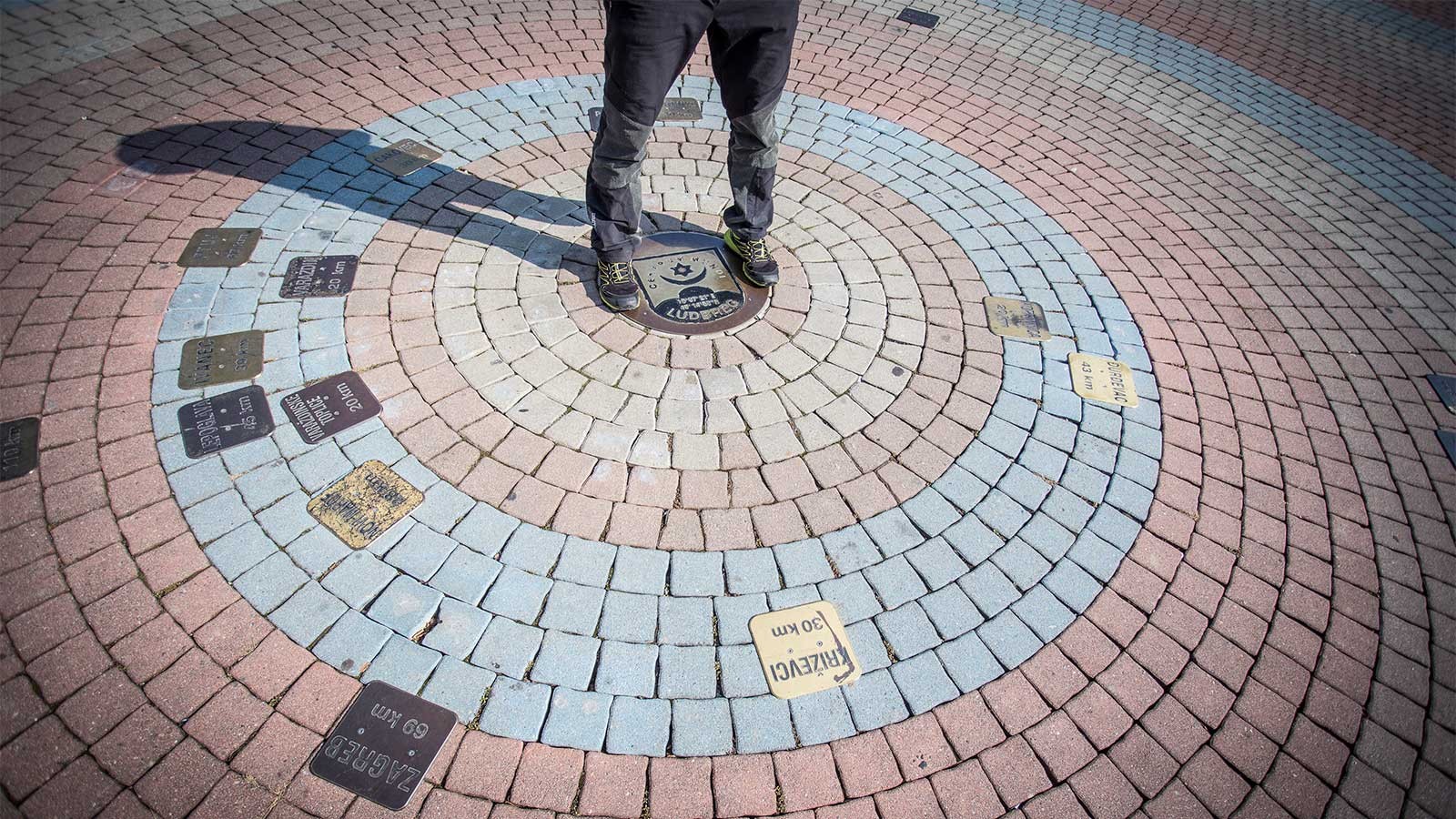
Visit Ludbreg, Centre Of The World © Croatian National Tourist Board / Bojan Markicevic
However, as much as the town might name-check Paris, Athens, Vienna and Budapest on its monument, there's actually no escaping the fact that it is actually a direct product of its local environment. Its close proximity to the river Drava - an important trading route since before Roman times - its major tributary, the river Plitvice, and its placing on the river Bednja, are doubtless the reasons for its position. That it sits on the border of three county lines - Koprivnica-Križevci, Varaždin and Međimurje - might be a modern administrative allocation, but it gives an indication of Ludbreg's mixed identity. 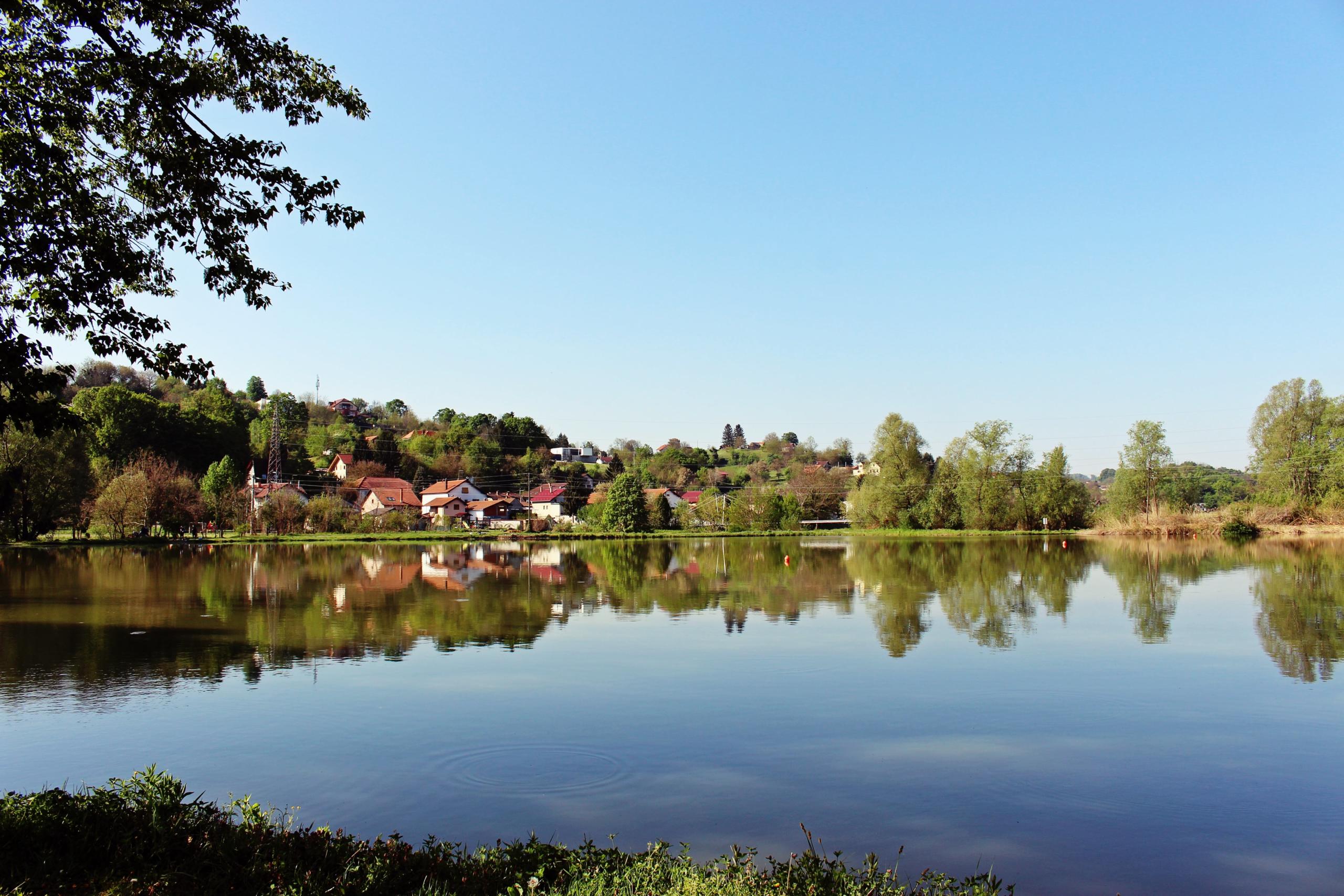
The best place to chill when you visit Ludbreg is Youth island © Ludbreg Tourist Board
To the town's east lie the vast flatlands of the Pannonian basin, to the south, a luscious green carpet covers the gently rolling hills of Zagorje, along the river Drava is the historic region of Podravina, stemming from the foothills of the Alps, to its north, historic Međimurje, then Austria and Hungary. You can see the land around the town juggle with this mixed identity, just as the town does; flat agricultural fields are interrupted by hills like Kalnički gorje or more gentle rises atop which beautiful holiday homes are placed. Nearer the centre of town, ultra-contemporary businesses lie next to routes of ancient pilgrimage. Neither here nor there, Ludbreg exists within a wonderfully mixed topography, with one foot in the past but a sharp eye on the future. 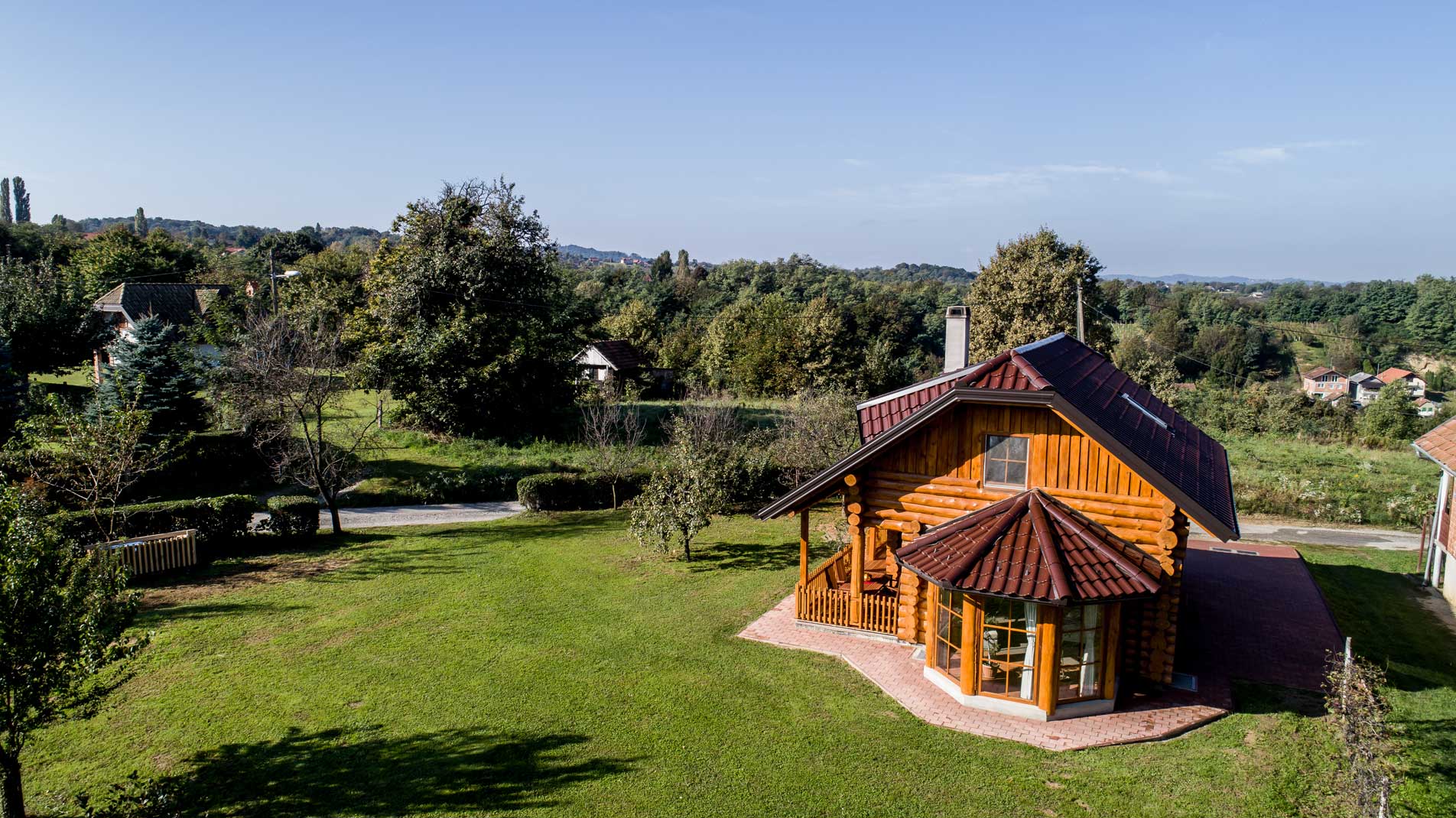
Hazelnut House holiday home, one option of where to stay when you visit Ludbreg © Varaždin Tourist Board
Why visit?
Truth be told, if you visit Ludbreg, you can see all of its sights in a day trip. And the town is perfect for just that. But, by doing so, you probably wouldn't get more than a tourist's glimpse of the place. Ludbreg is actually comprised of thirteen settlements that exist around the centre and it is within these quiet-looking hamlets and villages that most of the town's drive and ambition lie. This is where the people live. And, for a while, you can too. The whole town has a reputation for sustainable living and sustainable growth - pioneering waste management schemes, growing allotments granted to residents without gardens and technically advanced green power solutions. It is in these settlements that you'll find holiday homes designated to agro-tourism and ecotourism. Perfect for relaxing alongside only your nearest and dearest, they hold distinct, unique architecture, some have outdoor swimming pools and all are surrounded by clean, fresh air and nature. 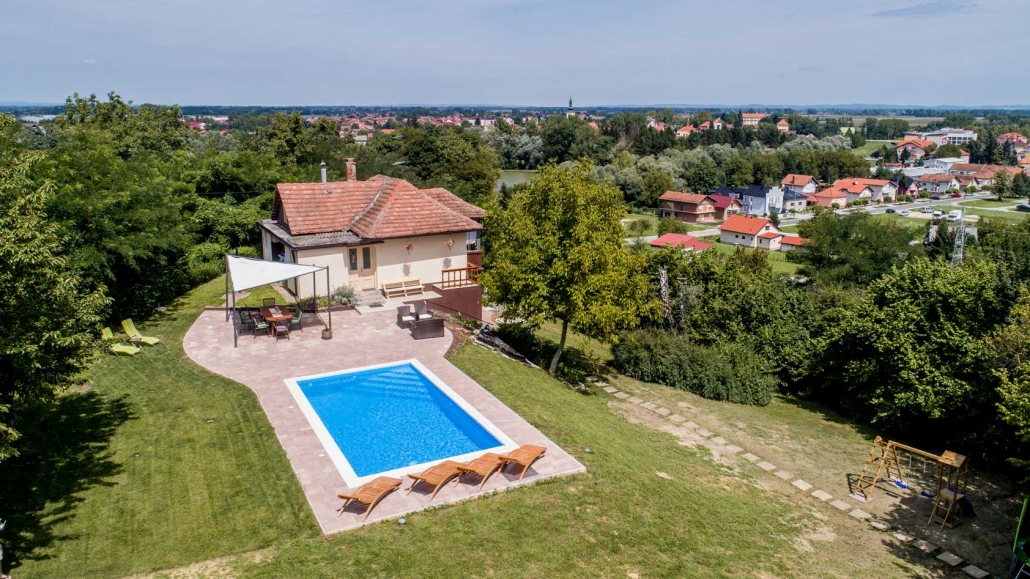
Villa Mila holiday home, another great place to stay when you visit Ludbreg © Varaždin Tourist Board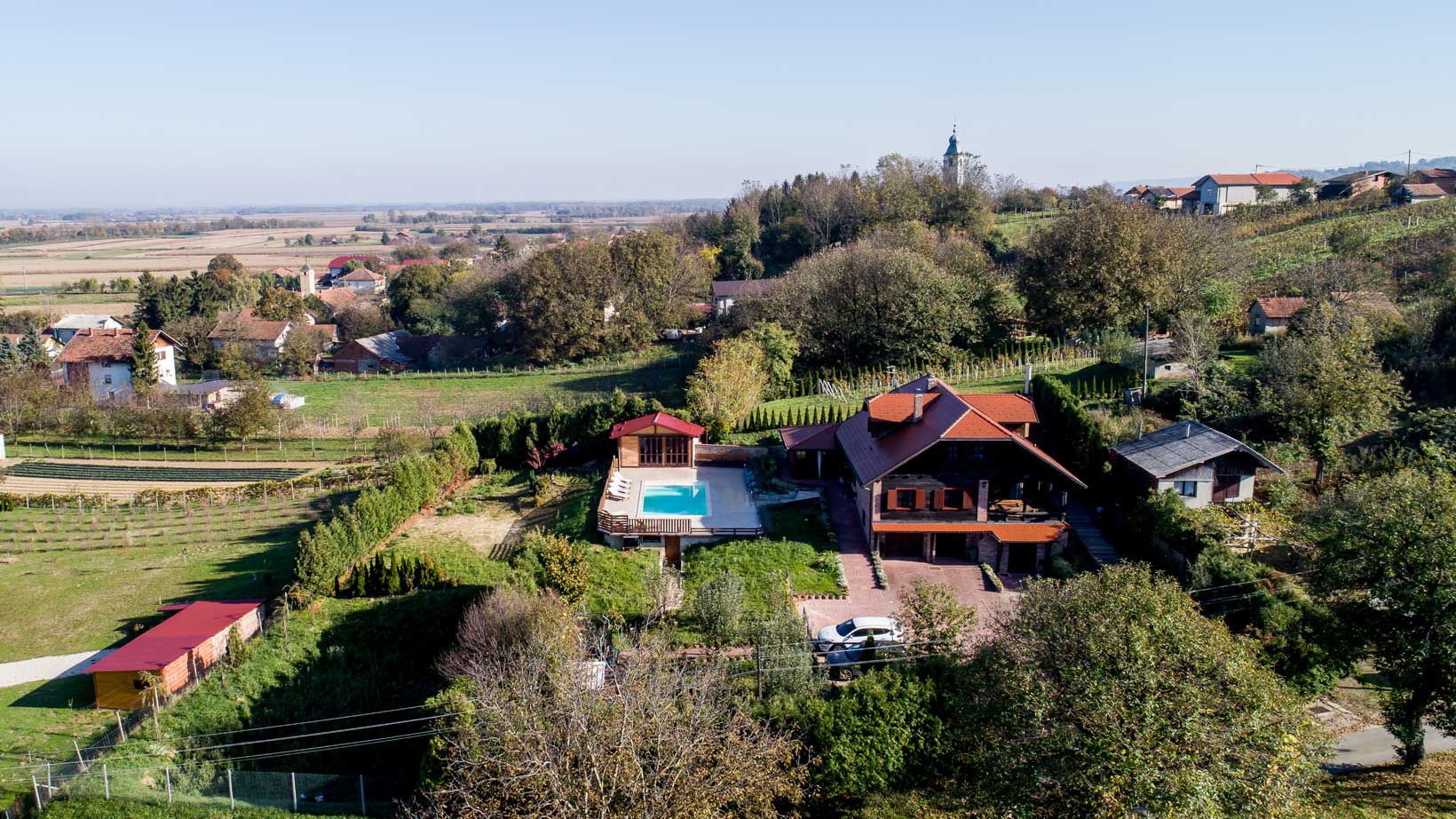
Rural House Gabrijela holiday home - you can get close up to nature and still keep the swimming pool when you visit Ludbreg © Varaždin Tourist Board
The bountiful nature surrounding Ludbreg is one which services the town's ancient industries, traditions and arts & crafts. Some of these you can see or join in with, the most famous being Ludbreg's wine roads. Take a tour of the area's vineyards, cellars and winemakers to sample great examples of continental wine. White wines are their forté and Graševina, Riesling, Pinot Blanc, Pinot Gris, Sauvignon, Chardonnay and Traminac are just some of the major league players available here, alongside rarer names like Moslavac and Manzoni. Muscat, Pinot Noir, Frankovka, Cabernet Sauvignon and Poštenjak can also be sampled.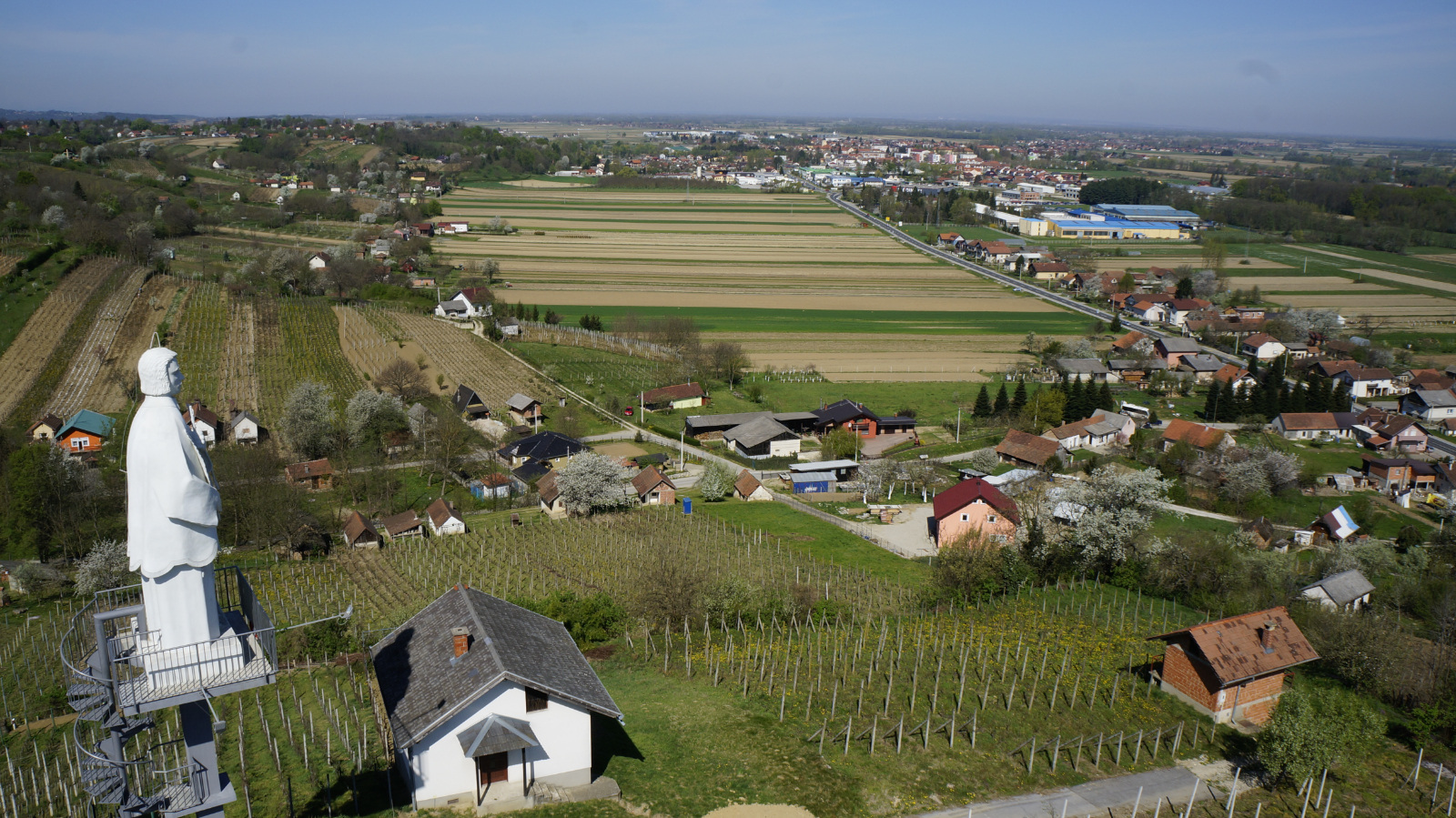
The wine roads surrounding the town are one of the best activities when you visit Ludbreg © Ludbreg Town
Alongside the sights, the other thing to catch when you visit Ludbreg is the events. In these regards, Ludbreg punches well above its welterweight. The town's event calendar is brimming with exciting or entertaining things to see and do. It wasn't so long ago that hundreds of participants and spectators from 33 countries descended on the town for the annual World Model Aircraft Championships. Ludbreg is used to happily hosting such hordes, its institutions beckoning thousands of visitors every year.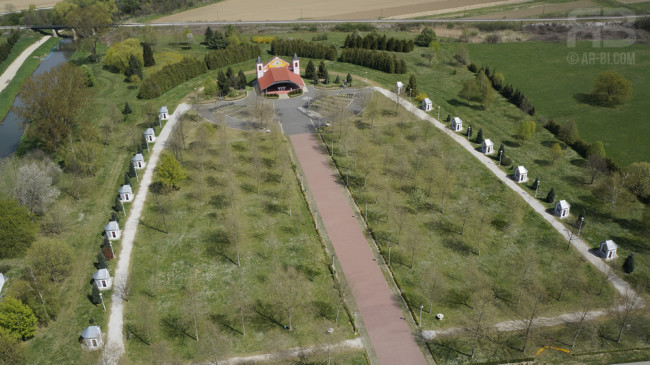
The peaceful approach to the pilgrimage site - one of the more famous reasons to visit Ludbreg © Ludbreg Tourist Board
The most famous of these institutions is the Catholic faith. Whether you believe the town to be named after a returning Crusader or an entranced winemaker, one history of Ludbreg holds a greater clarity due to its acknowledgement by the Vatican. Many people visit Ludbreg on devout pilgrimage because the Blood of Christ is said to exist here. When doubt entered into the mind of a local priest performing the Eucharist, it is said the vessel he held became filled with the actual Blood of Jesus Christ. Pope Julius II began investigating the claim thoroughly, so much so, that the miracle wasn't confirmed until the reign of his successor, Pope Leon X, in 1513. Pilgrims have visited Ludbreg ever since. The relic of the Precious Blood of Jesus is kept in Ludbreg's parish church of the Holy Trinity, although a special site for pilgrims was built on the edge of the town centre in 1992.
The pilgrimage site which the faithful flock to when they visit Ludbreg © Fraxinus
The most-famous architectural building in Ludbreg (and the prettiest) is the Baroque castle Batthyany. The castle dates from the reconstruction of the older medieval castle on the same site by Count Louis of Batthyany in the mid-18th century and today houses the workshop of the Croatian Restoration Institute. There, painstaking repair work is undertaken on historical items from all over Croatia which have been damaged by the years or in the war of the 1990s. Walking around the ultra-modern town centre of Ludbreg offers no clue that behind this castle's walls such careful preservation of the past is taking place.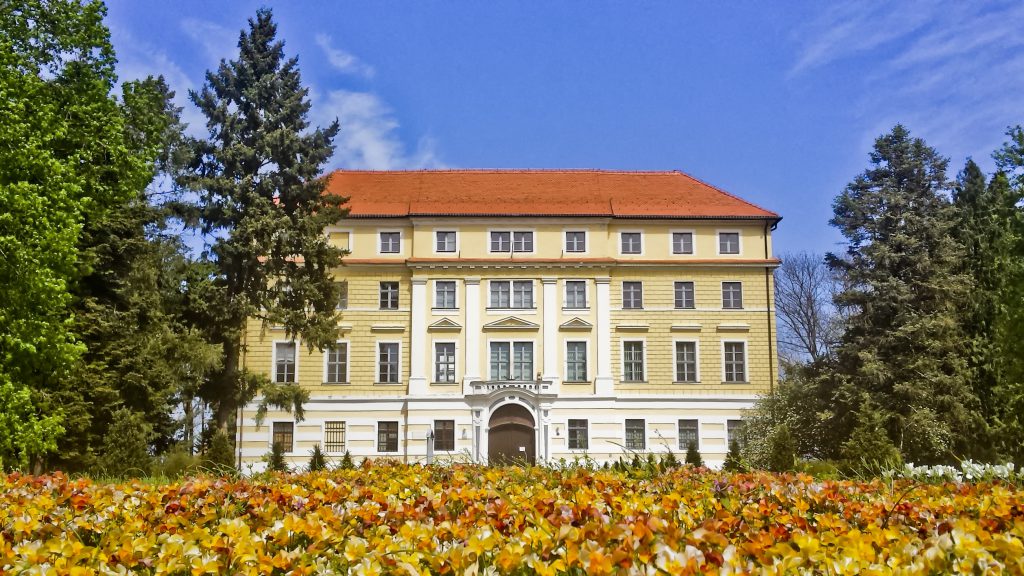
Batthyany castle in Ludbreg © Ludbreg Town
The other great institution of Ludbreg is also one which dedicates its life to preserving the past, but the history it protects belongs to the people, not the church. The cultural and artistic society KUD Anka Ošpuh, named after a female Partizan hero, has been operating in Ludbreg since 1976, although its roots are older. Many female-led charitable organisations operate in and around Ludbreg. That much of this work has existed in such hands for up to 150 years is simply remarkable, particularly within a broader Croatian society still viewed as patriarchal. Traditionally, while the young men of Ludbreg were drawn to more manly pursuits such as sports, bombastic brass instrument-playing and all-male choirs rooted in those of the church, the town's women were instead occupied with chores, charity work and the songs, dances and costumes of folklore. Folklore societies and their preservation of local, peasant traditions became incredibly popular all over Croatia after the Second World War. Early examples in the area of Ludbreg include Braća Kavurić from Martijanec (founded 1945) and that of Kutnjak (1947) with similar established in Sveti Đurđ, Sesvete Ludbreški, Dubovica and Vrbanovac. 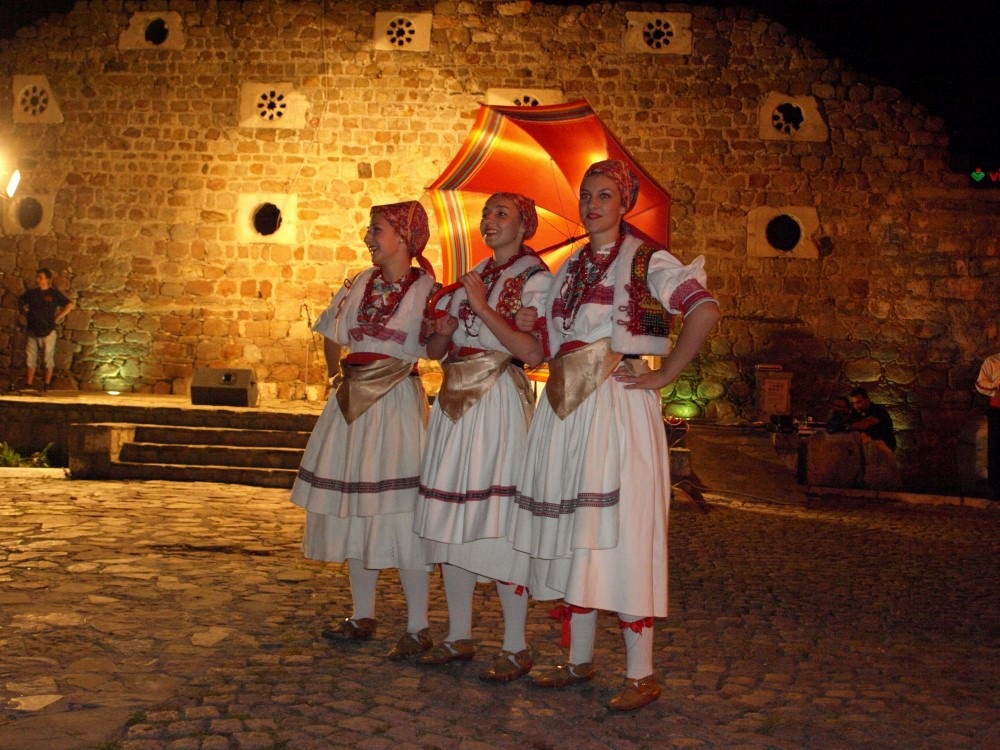
Contemporary members of folklore society Anka Ošpuh © Ludbreg Town
These village societies were mixed, but with the absence of any such society in central Ludbreg, it took 22 women to form the town's own. They made a great success of doing so. Although initially so poor with resources they had to practise in the basement of factories and local houses, by 1977 the society had grown to contain 79 members and was able to establish its own group of attached tamburica musicians and an all-female choir. As their reputation grew, the society absorbed many key contributors from similar groups in surrounding villages and their assets. To the 12 valuable Moslavina folk costumes with which they began, KUD Anka Ošpuh were able to add examples from Podravina, Slavonia, Dalmatia, Lika and even some worn by Croats in Vojvodina (present-day Serbia). Many of these costumes are still preserved or worn by society members to this day, kept alive, like the songs and dances of the region, by the society. These days, KUD Anka Ošpuh is one of the most highly regarded in Croatia and has performed all over the country, plus internationally at folk song and dance festivals. Its essential work is passed down to children and young people of the area in order that these traditions survive. Highly skilled and beautifully presented, they offer a glimpse of authentic and historic local culture. If you get the chance to see them, you simply must.
Ludbreg © Ludbreg Town
How to get to Ludbreg: The town lies approximately 100 kilometres by road from Zagreb, with bus or car being your options. Ludbreg has its own train station with trains running direct to Zagreb, Osijek and Varaždin.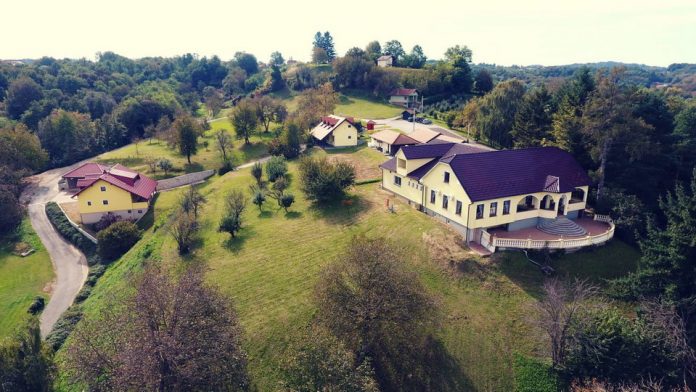
Črn-Bel restaurant © Črn-Bel restaurant / Luka Krušec (LuMedia)
Where to eat: Surrounded by vineyards and beautiful nature, the Črn-Bel restaurant is a brilliant spot for lunch or dinner. They do great grilled meats, superior pizzas from a wood-fired oven and sharing platters, with most ingredients sourced locally. Restoran Raj in the town centre is much more of an informal, family place, with pizzas for the kids and shared grills or deep-fried seafood for the parents.
Where to drink: Pivnica Mejaši is a great pub in the centre of town where you can refresh yourself. They have a lovely, covered outdoor terrace and a good pub-grub menu, including pizzas, which will satisfy for lunch or an informal evening meal.
Ludbreg's first piece of street art is a mural of the moon © Ludbreg Tourist Board
What's new: Although the 'Centre of the World' is the star of the town's main square, you'll not miss several new additions to their menu of monuments. The latest is an artwork dedicated to young, local athlete Sara Kolak, a javelin player who earned a Gold medal for Croatia at the 2016 Olympics. She shares the square with a fountain, a photo opportunity spot and a remarkable solar-powered tree where you can charge your phones and other devices for free. For the cool cats, the town has a brilliant mural of the moon on one building facade – it's Ludbreg's first street art piece. The town will host a conference on cycling tourism from 16 – 18 September 2020.
Ludbreg's town centre © Ludbreg Town
What not to miss: For a small place, the list is huge. Don't miss the parish church of the Holy Trinity, its interior is delightful. You must visit the castle too and take the pilgrim's walk up to the modern ecclesiastical point of worship. LUMEN, a Ludbreg youth organisation, hold great music and theatre events. Centre of the World Day is April 1 and everyone joins in during the town's big day. The fountain on the central square flows with wine for the occasion. The town's carnival sees joyful residents march the chilly streets in costume. It's 164 years old and takes place on Shrove Tuesday. Ludbreg's Advent festivities grow year upon year. Also in winter, at the end of January, the town's winemakers present their fresh batches at the Young Wine Days.
Ludbreg's central square. During its three-day International Flower Festival, the town explodes with even more natural colour © Ludbreg Tourist Board
The town's three-day International Flower Festival is the second biggest in Croatia and is an explosion of natural colour. You can visit it at the end of April / beginning of May. The Ludbreg Bike Tour is a 15 kilometre run around the town, with a great afterparty at the picturesque Youth Island (main picture). Two more great parties are Idemo Otok in June and Crazy Island in August. Strange to imagine such a small place hosting two electronic music festivals of such far-reaching repute, but it does. Young dance music enthusiasts from all over Croatia travel here to attend them. Again, they take place on Youth Island. Although pilgrims visit throughout the year, many reserve the journey for the seven days surrounding Holy Sunday. KUD Anka Ošpuh holds folklore events throughout the year including a memorial performance for former president Mirjana Bošnjak, a springtime celebration, Ludance (which focusses specifically on local folklore), a wintertime celebration, Christmas show and, pick of the bunch, Folklore Meetings in the Centre of the World, during which they're joined by outside folklore societies. KUD Anka Ošpuh's great tamburica orchestra also play many dates independently, as do the once-attached but now independent, all-female Podravina choir.
What to buy: Ludbreg has had a beekeeping society for over 70 years and local beekeepers know their stuff. Ludbreg honey is a great gift to take home, as are any of the bottles of fine wine produced around the town.
Ludbreg's town centre © Ludbreg Town
On these links you can read about the other destinations in our The Croatian Road Less Travelled series:
Osijek - the capital of Slavonia, on the banks of the Drava
Donji Miholjac - a hidden gem in the heart of the Pannonian basin
For the latest news from Ludbreg, check out the dedicated TCN section.
For the latest travel info, bookmark our main travel info article, which is updated daily.
Read the Croatian Travel Update in your language - now available in 24 languages
Ludbreg, Croatia's Miracle Town: Vatican-Recognised Unlike Medjugorje
November 2, 2019 - More than a million religious tourists visit Medjugorje every year, even though the Vatican has not authenticated anything there, but few know about the only Vatican-authenticated miracle in Croatia which can be visited. Meet the Eucharistic Miracle in Ludbreg.
My first visit to Croatia in what was then Yugoslavia was back in 1988. I remember overnighting in Zagreb before heading to the destination which was the main purpose of the trip.
Medjugorje.
As I was the product of nine years of Jesuit education in a British boarding school, the Catholic faith was never far away. Indeed, so strong was the influence that I went to voluntary mass six times a week at 07:20 before lessons began, and I even contemplated becoming a priest at one stage. And so when I learned of the alleged apparitions in Medjugorje, I knew I had to visit this miraculous place.
But when I arrived, there was nothing concrete to see. Apart, of course, from apartments, so many apartments. This was a small village which had exploded in just eight years after six children claimed to have been visited by the Virgin Mary while tending goats. More apparitions occurred, and the Virgin Mary sends a message to one of the (now adult) visionaries on the 25th of each month. But there was nothing to see, apart from the hill where the sightings allegedly happened, and a big church in the centre of town which became the religious focal point.
The religious tourism industry - for it is an industry - has transformed Medjugorje, which now welcomes over a million religious tourists a year, the majority of whom spend a few days. Think about that for a second - one small town in Hercegovina attracts 5% of Croatia's entire tourist arrivals each year, and it attracts them 12 months a year.
I have spent a lot of time in Medjugorje over the years. It is a place which sharply divides opinion between those who are fervent believers in the apparitions to those who are equally fervently convinced that the whole thing is an elaborate con which has become a great money-making machine for all. My opinions are not relevant, but one which is is the opinion of the Catholic church itself and the Vatican in particular. And this is where I got really surprised, especially as I read somewhere that Medjugorje is apparently the second most visited Catholic destination for religious tourism in Europe, possibly the world, I can't remember.
And yet neither the local bishop or the Vatican itself has officially endorsed it. Indeed, the local bishop has gone on record to state the apparitions are not credible, as recently as last year.
And even without this official endorsement, still more than a million people come each year - that is a tourism miracle in itself. I have met many people who have been to Medjugorje, and there is no doubting their beliefs or that being there gives them peace.
In terms of a religious tourism destination, the numbers are incredible.
Every time I have driven away from Medjugorje over the years, I wonder what Croatian tourism would make of a fully authenticated miracle by the Vatican.
And then I found out that one exists, fully authenticated by the Vatican. In Ludbreg in Varazdin County.
The Real Presence website gives a great overview of the history of Ludbreg's miracle.
In 1411 at Ludbreg, in the chapel of the Count Batthyany’s castle, a priest was celebrating Mass, during the consecration of the wine, the priest doubted the truth of transubstantiation, and the wine in the chalice turned into Blood. Not knowing what to do, the priest embedded this relic in the wall behind the main altar. The workman who did the job was sworn to silence. The priest also kept it secret and revealed it only at the time of his death. After the priest’s revelation, news quickly spread and people started coming on pilgrimage to Ludbreg. The Holy See later had the relic of the miracle brought to Rome, where it remained for several years. The people of Ludbreg and the surrounding area, however, continued to make pilgrimages to the castle chapel.
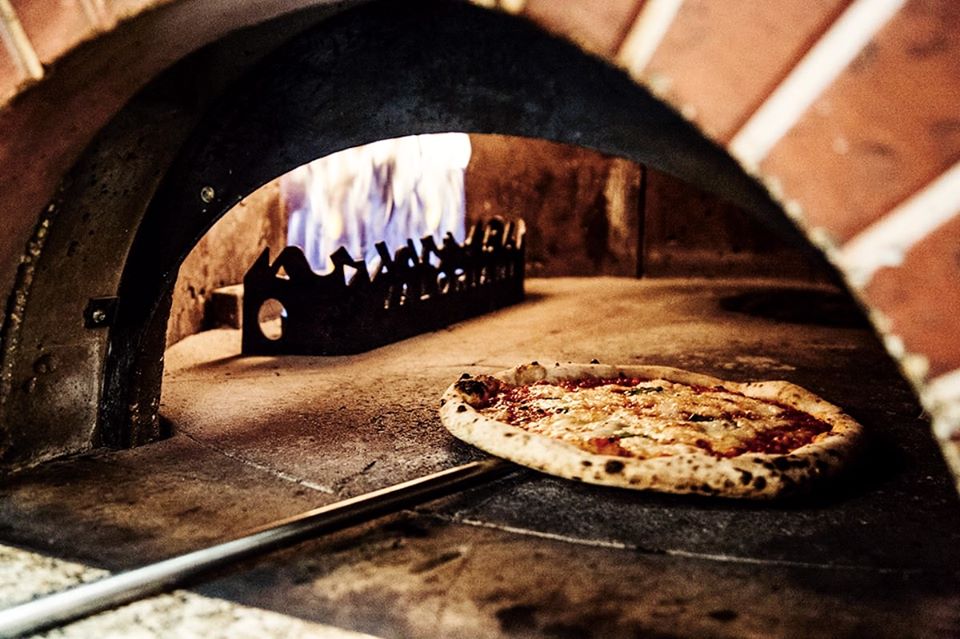
In the early 1500s, during the pontificate of Pope Julius II, a commission was convened in Ludbreg to investigate the facts connected with the Eucharistic miracle. Many people testified that they had received marvelous cures while praying in the relic’s presence. On April 14, 1513, Pope Leo X published a Bull permitting veneration off the holy relic which he himself had carried in procession several times through the streets of Rome. The relic was later returned to Croatia.
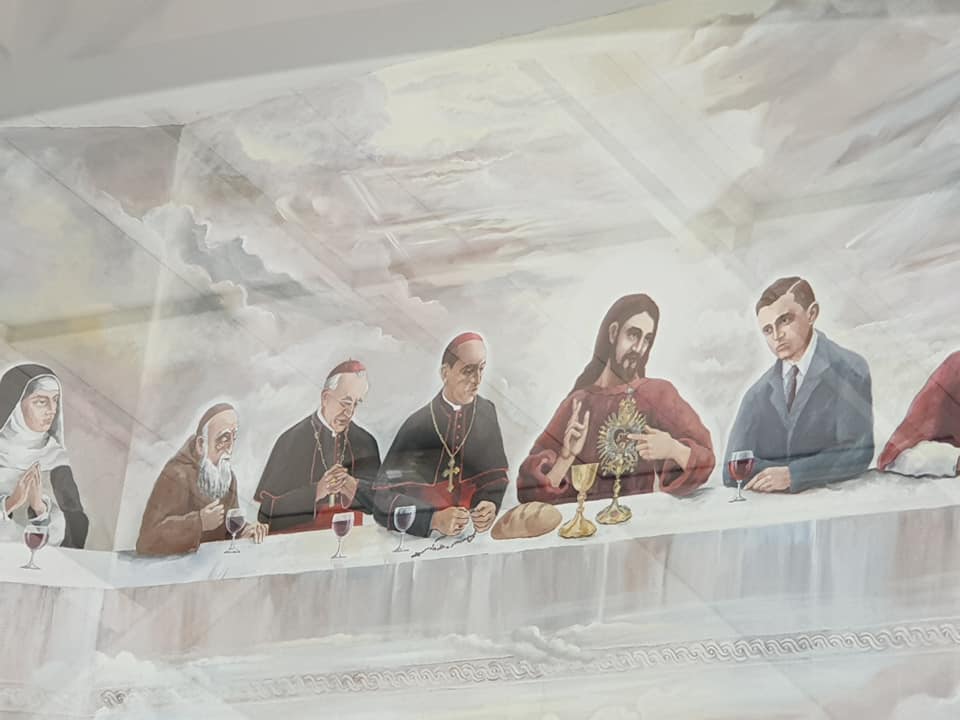
In the 18th century northern Croatia was ravaged by the plague. The people turned to God to call upon His help, and the Croatian Parliament did the same. During the session held on December 15, 1739 in the city of Varazdin, they vowed to build a chapel at Ludbreg in honor of the miracle if the plague ended. The plague was averted, but the promise vow was only fulfilled in 1994, when democracy was restored in Croatia. In 2005 in the votive chapel, the artist Marijan Jakubin painted a large fresco of the Last Supper in which Croatian saints and blesseds were drawn in place of the Apostles. St. John was replaced with Blessed Ivan Merz, who was included among the 18 most important Eucharistic saints in the Church’s history during the Synod of Bishops held in Rome in 2005. In the painting, Christ is holding in His hand a monstrance containing the relic of the Eucharistic miracle.
Croatian speakers can learn more about the miracle in the video above.
And this is where things got rather extraordinary, to me at least. I have asked a LOT of Catholic friends here in recent days if they know about the Ludbreg miracle. Most only knew about Ludbreg as the centre of the world, others knew that there was some kind of pilgrimage in September, but a miracle? The only Vatican-authenticated one in all Croatia that you can actually visit? Not one person.
Amazing.
And yet people DO know about it, at least 100,000 people. For that is the number of pilgrims who gather in Ludbreg each year in the first week of September for a special commemoration of the miracle in the park in front of the church constructed in 1994. Check out some footage from this year's pilgrimage above.
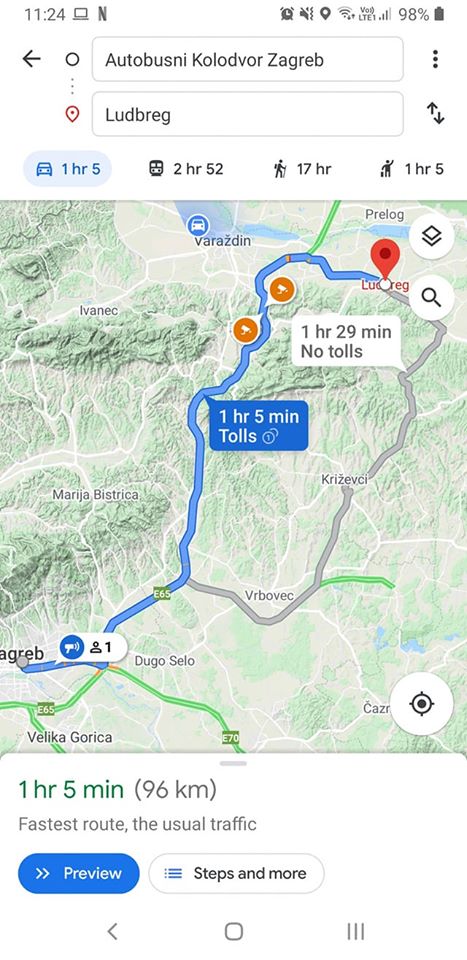
And for the rest of the year, apart from Easter, the church and the park are completely unused.
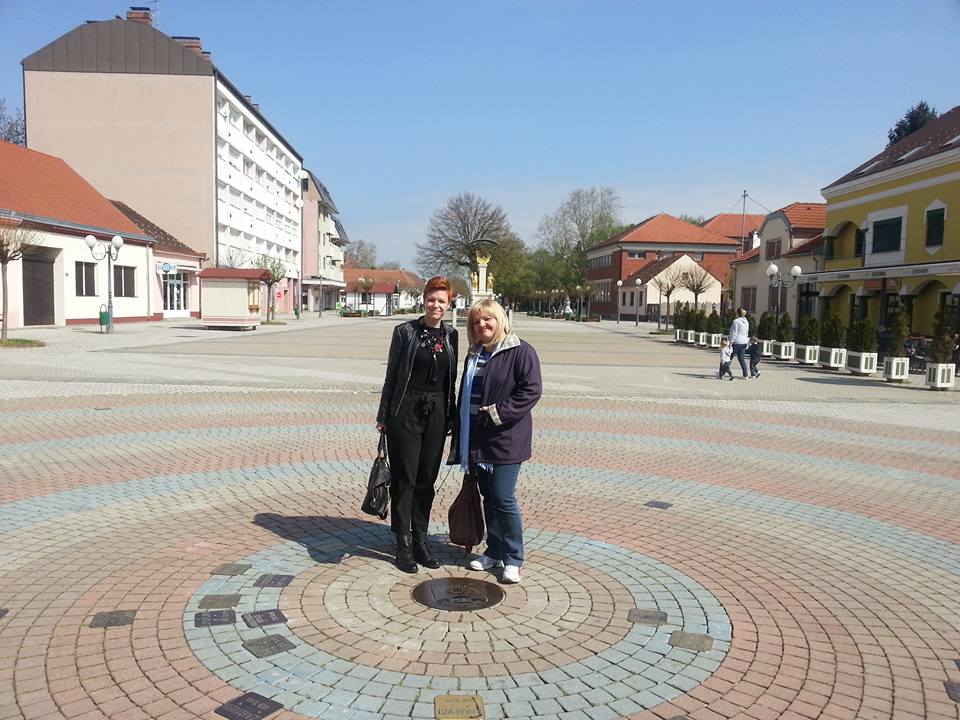
The park comes with its own Stations of the Cross.
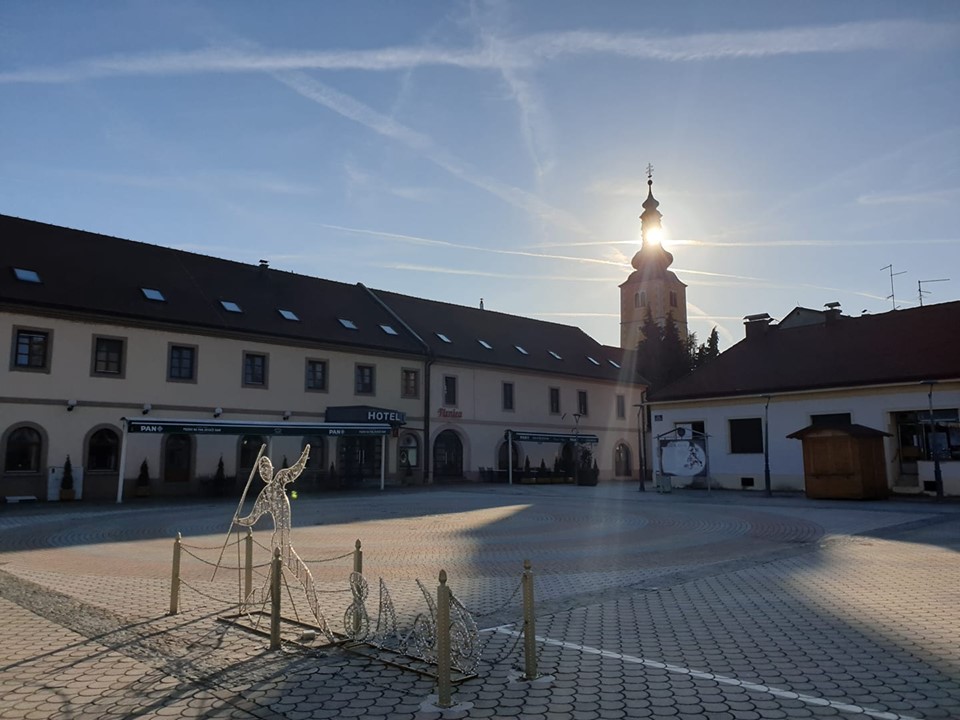
The 1994 church, however, is not where the miracle chalice is held. It is to be found in the Most Holy Trinity Church in the centre of town, just off the main square and the centre of the world.
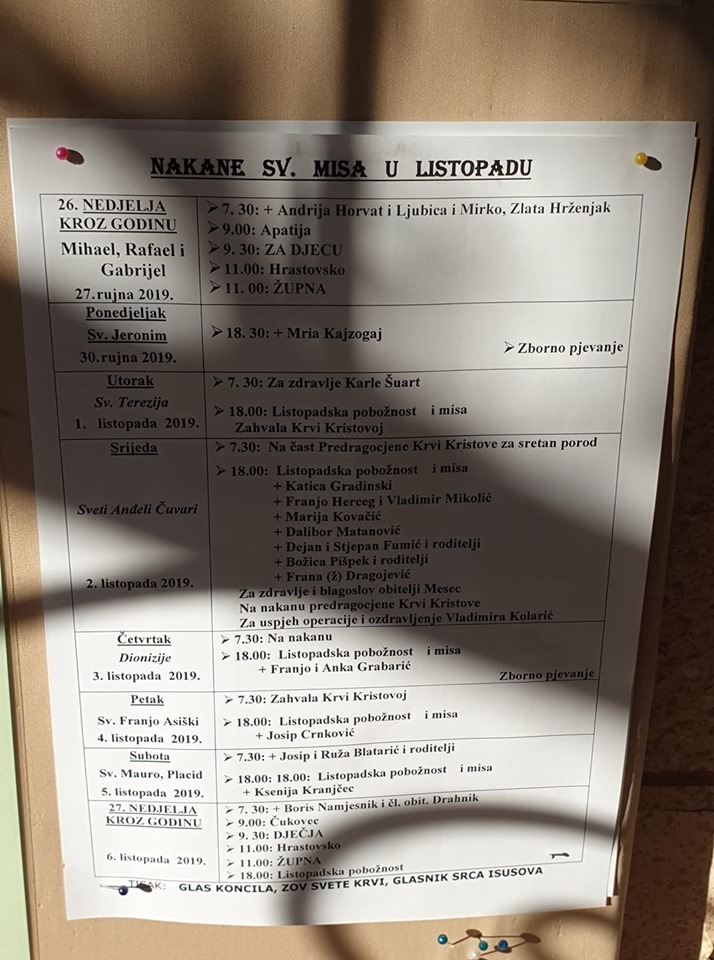
One of the challenges of seeing the miracle chalice is that the church is closed a lot of the time, but with a little careful planning it can be visited every day. For mass is held daily, the chance to worship in the presence of Croatia's only authenticated miracle. Mass times for October above - making this information available online and in English would be easy to do.
And it turns out that this is exactly what is already happening, but on a very limited scale. Ludbreg has a steady trickle of tourists from Poland, I learned. They arrive by bus and spend the night in Ludbreg before attending mass in the morning and continuing their journey to their end destination - Medjugorje. From the town with the authenticated miracle to the town without Vatican approval but with over a million tourists a year.
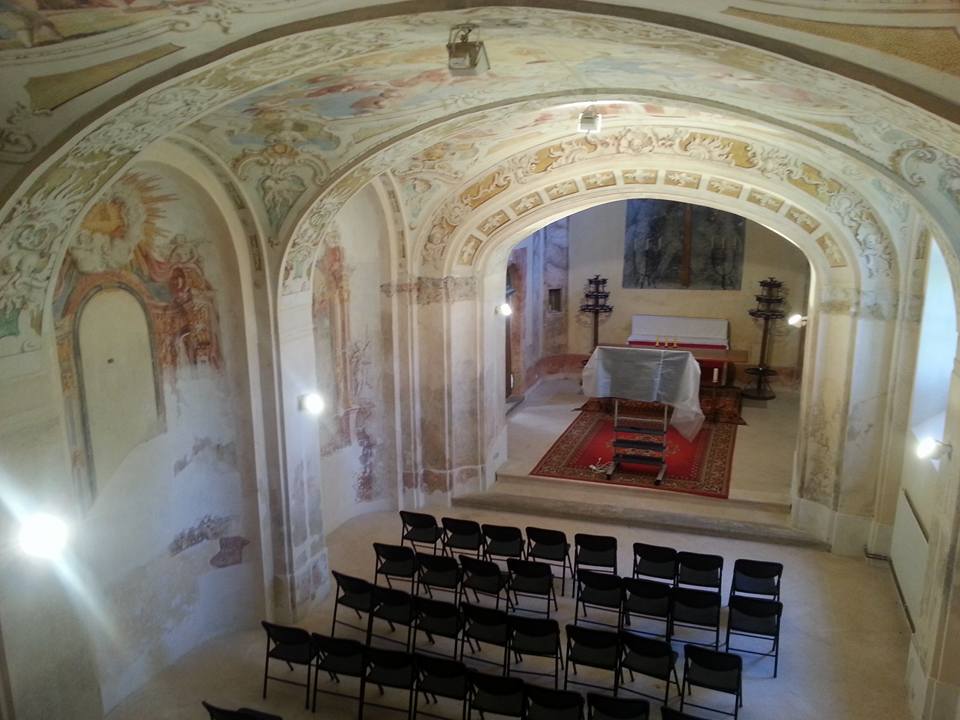
From what I learned during my last visit to Ludbreg, although the Polish pilgrims go to mass in Ludbreg, they do not visit the original chapel where the miracle took place.

Which is a shame, as it is REALLY pretty and has some rather fascinating things to see is the small exhibition area behind it.
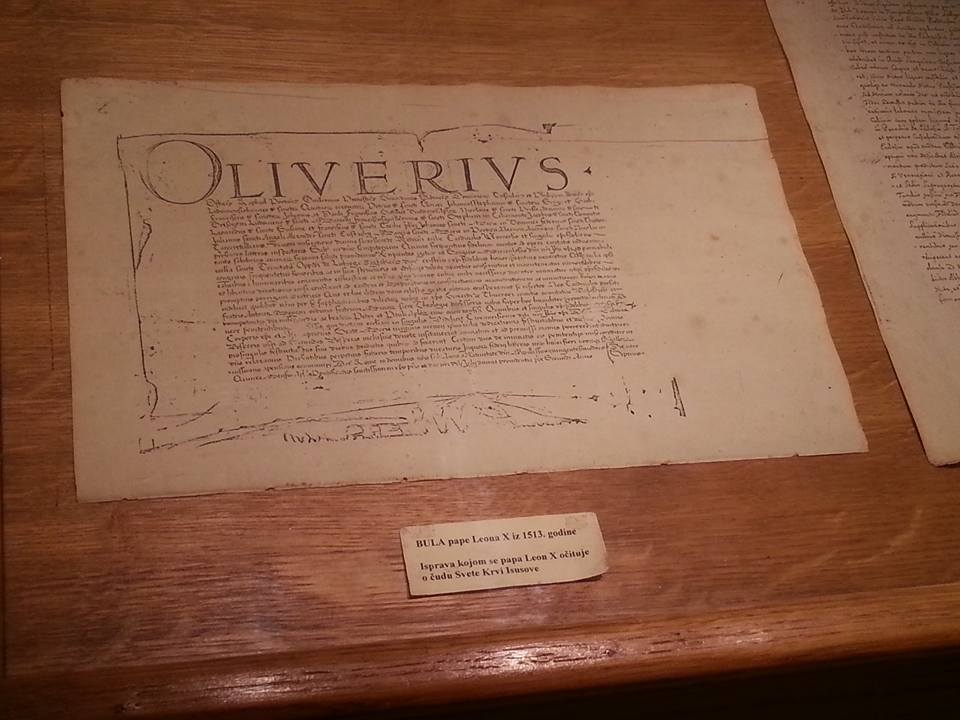
Including the papal bull of Pope Leo X in 1513.
Religious tourism is a niche product, and it is not for everyone, but as Medjugorje has proved, it motivates people to travel. And as Croatia looks to extend its season and develop tourism in continental Croatia, is it sitting once more on a hidden jewel, this time in the niche of religious tourism? If religious tourists from Poland are already coming to Ludbreg, that is proof that this incredible little story is attractive to the niche market. The fact that it is 7.5 hours from Medjugorje and not far off the bus routes of many pilgrims going to Medjugorje by bus from Central Europe surely means that there is a market with captive audience to be developed. Word of mouth passes quickly in such niche markets, and if the majority of Catholics even in Croatia know almost nothing about the Ludbreg miracle, one assumes the same is true elsewhere. But some Poles know about it and are sufficiently interested to visit with the current set up. As I understand it, they are also able to have the mass said in Polish by their accompanying priest.
Imagine if Ludbreg could expand its religious content, as well as better promotion of its authenticated miracle. While nobody is suggesting we have a new Medjugorje in terms of tourist arrivals, that current Polish trickle could turn into a very steady stream. A little thought into better use of the current religious offering in Ludbreg and better promotion is pretty much all that is required.
And the components are already there. Instead of just mass and then an onward journey that the Polish tourists currently experience, include a tour of the original chapel with its gorgeous frescoes. Visit the exhibition by the chapel and learn about the papal bull and more. Stroll over through the park to the 1994 church built in belated thanks for averting an 18th-century plague. Do the Stations of the Cross in the park, then learn more about Croatia's saints in the unique Last Supper fresco to be found at this church. And then perhaps an early lunch - choose from Croatian, Italian, Mexican and American cuisine at the appropriately named Hotel Raj across from the park - Raj in Croatian means 'heaven.'
Too fanciful? I personally don't think so, especially as the Polish pilgrims have already proven the interest.
As I was driving away from Ludbreg, I thought of the possibilities of religious tourism and realised that this is a tourism niche that has been largely overlooked until now. Croatia has some INCREDIBLE religious sites (Blaca Monastery on Brac, say no more) and processions (Za Krizen on Hvar, The Assumption of Mary in Sinj), and some wondrous occurrences that are not certified as miracles (Our Lady of Trsat, the Black Madonna of Marija Bistrica). And yet there is no central exhibition centre or museum where one can learn about Croatia's diverse and truly fascinating religious heritage. So why not build create one and give even more content to visitors. And where better than in the Croatian Miracle Town of Ludbreg - developing tourism continental Croatia and developing a year-round religious tourism niche at the same time? But that perhaps is a topic for another day.


